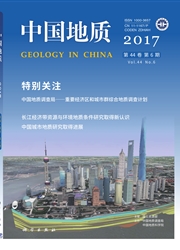

 中文摘要:
中文摘要:
河南祁雨沟金矿位于华北克拉通南缘的熊耳地体.产于燕山期火山隐爆角砾岩筒内。流体包裹体研究表明.祁雨沟金矿不同成矿阶段的石英中的流体包裹体有3种类型:水溶液包裹体、含子矿物包裹体和含CO2包裹体。成矿早期流体为高温(〉350℃)、高盐度(〉30wt%NaCl.eqv)、高氧逸度、富CO2的岩浆流体,经流体减压沸腾、挥发分逸失、氧逸度降低、温度降低演化为导致大量金属硫化物及金沉淀的还原性流体.再经大气降水的混入和降温等过程.演化为晚阶段低温、低盐度的大气降水热液。祁雨沟金矿的地质和成矿流体特征指示其应为爆破角砾岩型.而非浅成低温热液型.
 英文摘要:
英文摘要:
The Qiyugou gold deposit, Songxian County, Henan Province, is associated with subvolcanic breccia pipes in the Xiong'er terrane, southern margin of the North China craton. In hydrothermal quartz three types of fluid inclusions can be observed. They are H2O-rich, daughter mineral-bearing, and CO2-rich. The initial ore- forming fluids are magmatic in origin and characterized by high temperature (〉350℃), high salinity (〉30wt% NaCl.eqv), high oxygen-fugacity and CO2-rich. Then the fluids boiled and resulted in CO2-release, oxygen- fugacity decrease and rapid precipitation of ore-forming materials. The late stage fluids, characteristic of low temperature, low salinity and lack of daughter mineral, could be sourced from meteoric water. The ore-forming fluid system and geological characteristics of the Qiyugou gold deposit suggest that it is a typical explosive breccia-type gold deposit, instead of an epithermal-type deposit.
 同期刊论文项目
同期刊论文项目
 同项目期刊论文
同项目期刊论文
 Isotope systematics and fluid inclusion studies of the Qiyugou breccia pipe-hosted gold deposit, Qin
Isotope systematics and fluid inclusion studies of the Qiyugou breccia pipe-hosted gold deposit, Qin The Shanggong Gold Deposit, Eastern Qinling Orogen, China: Isotope Geochemistry and Implications for
The Shanggong Gold Deposit, Eastern Qinling Orogen, China: Isotope Geochemistry and Implications for Geology and D-O-C isotope systematics of the Tieluping silver deposit, Henan, China: Implications fo
Geology and D-O-C isotope systematics of the Tieluping silver deposit, Henan, China: Implications fo Comparison of the typical metallogenic systems in the north slope of the Tongbai-East Qinling Mounta
Comparison of the typical metallogenic systems in the north slope of the Tongbai-East Qinling Mounta Isotope geochemistry of the Weishancheng stratabound gold-silver ore belt, Tongbai County, Henan Pro
Isotope geochemistry of the Weishancheng stratabound gold-silver ore belt, Tongbai County, Henan Pro Origin of gold metallogeny and sources of ore-forming fluids, in the Jiaodong province, eastern Chin
Origin of gold metallogeny and sources of ore-forming fluids, in the Jiaodong province, eastern Chin Ore geology, fluid geochemistry and genesis of the Shanggong gold deposit, eastern Qinling Orogen, C
Ore geology, fluid geochemistry and genesis of the Shanggong gold deposit, eastern Qinling Orogen, C 期刊信息
期刊信息
